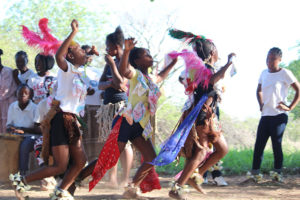
Life Inside a Fenced-in Enclosure with a Pride of Seven Wild White Lions
By Dianne G. Brause
Probably most of you know the Bible Story of Daniel in the Lion’s Den? And maybe you remember the Roman tale of Androcles, the man who had taken a thorn from the paw of a lion as a young man, and was later saved in the Roman Arena by that same lion, that chose to protect him rather than to tear him to shreds?
But likely, none of you know the modern, true story of Linda Tucker, who, in 1991, was saved by the courageous acts of an old African woman who walked into a pride of 24 angry lions who had been attending the birthing of a lion baby born in the bush. Linda and others had foolishly ventured out in a jeep to see the predicted birth of an endangered sacred White Lion cub. As fate would have it, the jeep hit a rock and became disabled, unable to move, quite near the pride, which did not take kindly to this disruption. And as the night began to fall, the lions were roaring their displeasure at such a rude and disrespectful act on the part of the stupid two-leggeds, stranded nearby in their open jeep!
Just as the lions seemed ready to defend their precious new arrival, into their midst walked Maria, an ancient Black African “sangoma,” known locally as “The Lion Queen of Timbavati,” who calmed them down to the point where one of the inhabitants of the Land Rover could safely go back to the village for help—without the threat of being torn to shreds.
Now, although I spent a month living within the conservancy of the Sacred White Lions, now rescued and able to live freely within a large acreage owned by Linda’s Global White Lion Protection Trust, this does not mean that I was really in danger of such an attack—assuming that I or others within our group of nine participants did not break the rules of respectful encounter and observation of the pride. And to be honest, we all lived locked within a smaller enclosure protected from the lions and other wild beasts of the South African bush veld by live electric fences and locked gates.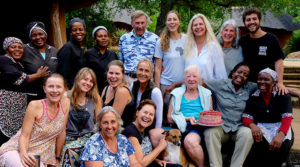
However, early each morning as the sun was rising, we would venture out in an uncovered Safari vehicle to look for the pride as part of a Ph.D. research project designed to log the social behavior of the White Lions. Our incredibly knowledgeable and compassionate guide, Rubin, would periodically place his H-shaped metal telemetry instrument outside the truck window and assess, from the clicks coming from the collars of the four adults, their general direction, relative distance and whether they were stationary or on the move. Often, “The Boys,” as we called the two adult males, would be out doing their job of patrolling the territory to make sure no rivals had breached the fencing overnight. And Mom, auntie, and the three cubs frequently lounged more discretely under the small bushes and trees, and thus were more difficult to spot from the dusty roads that crisscrossed the large acreage.
After searching for up to an hour, we might finally spot these magnificent animals, and each time, my heart would skip a beat with the majestic awe of them! Our guide would slowly pull the vehicle as close to them as possible, without risking a defensive response. We learned that they are considered the Kings of Kings in direct communication with the stars, within the African bush, and we were taught to honor them as such. The official protocol was to give them the honor of a King or Queen—meaning that we would bow our heads, and slowly look up, and then lower our eyes in an iconic “lion blink” before looking up to them. And they, most remarkably, would either honor us with a slow blink back before looking directly into our eyes—or if we didn’t seem to deserve their attention, they might turn and walk away back into the bush. For me, this honoring was totally magical, and being acknowledged in this way was incredibly mesmerizing.
Sometimes, especially on very hot days, they seemed pretty unimpressed by our presence and would look up and immediately flop back down to doze in the sun. But on some days, the cubs would decide to investigate this funny being with so many blinking eyes, and walk up to and around our vehicle. And occasionally, one of the adults would come over to us and walk around, looking into our eyes as they assessed the contents of our green safari vehicle. At those times, we all held our collective breath, to be close enough to touch the head or scratch an ear of this giant kitty in our presence.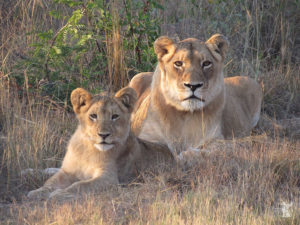
Often, I was in the center seat, and it took all of my self-control to not stand up and lean over for a personal touch, as I longed to befriend them personally. However, we had been forbidden to stand or reach out beyond our canvas side protectors in any way. And one day when we had a Tribal Elder in the front seat with the driver, I noticed that he immediately rolled up his window when one of the males came sauntering over, with his big head and mane on the same level as this healer. I was surprised at this reaction, since I felt so relaxed—but I also surmised that his man had more than likely lost friends to lion attacks over his 80+ years in the bush.
So what does all of this have to do with community and/or climate justice, you might ask? How it connects for me is that I observed, during our month in South
Africa, four distinct, but interconnected communities. The first was our little group of nine participants who had not known each other before, but were tasked with becoming a functional community during the month of our program called the “Academy for LionHearted Leadership™.” The second was the community of people who lived and worked within the compound to serve us in our learning adventure with the lions. The third was encountered on another property, which was also owned by the Global White Lion Protection Trust, where we spent a day being entertained by school children from the 10 schools that the Trust supports. They danced, sang, drummed, and performed poetry and little plays—all related to their teachings about the Sacred Star Lions of their collective and ancient culture. And lastly, although a small community, “our” lion pride was definitely a community within themselves, and each of these communities was connected and affected by the changing weather and climate in their own way.
And as to climate change, it is believed by Linda Tucker and others, who seem to be able to communicate directly with the White Lions, that these beautiful Beings have returned to this particular location on the earth after many years thought to be extinct, directly from the Stars with a message for humanity at this time in history—to warn us that we must CHANGE our ways, if we are to survive into the future. They warn us that we must come together in Unity with all other creatures on the planet as brothers and sisters, rather than dominant and submissive, tyrant and victim, more important and less important, in order to rebalance a world greatly out of balance. This was our lesson to learn while in South Africa among these incredible Star Beings.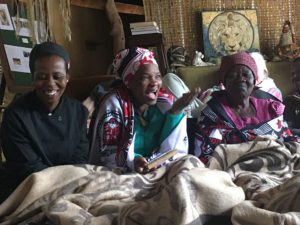
When we arrived in South Africa in mid-November, the land was very dry. Everything was tan or grey and very dusty after a prolonged drought, which affected man and beast alike. The heat was oppressive—on some days peaking above 100 degrees F. One of our participants from Maine actually chose to leave early, because he didn’t think he could endure the heat any longer. I found that during breaks in our program, I felt like lying down in the relative coolness of our beautiful rondavel made of mud and thatched roofing, with our fan turned on full-blast. I could tell that these traditional living structures had been developed to fit perfectly within the natural environment of the African bush, and I much appreciated their relatively cool interiors.
Fortunately, during the month, the drought subsided with a number of days of rainy, cool weather. Magically, the land turned green again, and grasses and little flowers began to grow all over the bush veld. And, toward the end of our stay, the newborn babies of all kinds began to be seen with their mothers within the herds of the various sizes of grazing animals such as the Wildebeests, Nyalas, and Duikers, as well as the Jackals, the nesting birds, and others. Unfortunately, we didn’t get to see any newborn, fluffy White Lion babies—but we did get to observe “our” teenage cubs learning how to hunt.
Our amazing guide, Rubin, would stop along the dirt roads crisscrossing the land, to teach us each day about one more species of tree, bird, or animal. I deeply appreciated learning how much the ancient African peoples had learned over the centuries in their abilities to utilize the interconnections within their natural environment. They observed and made use of the gifts of nature for their food, clothing, housing, healing, etc. This knowledge allowed them to survive over thousands of years within an environment which would be totally foreign and inhospitable to modern humans—since we have forgotten how to read the language of nature.
In one of our sessions, we each chose an animal that we saw and observed during our morning rides. I chose the Leopard Tortoise and learned that this creature lived up to 200 years of age, and could hold water within its shell to sustain it through times of drought. But if it were picked up, it would release its extra water—and thus might die in a time of drought. So when we saw a Leopard Tortoise on the road, we would stop and give it the right-of-way to move across the road without interference. I was also impressed to learn that within certain tribes, a person could not be chosen to serve as “King” unless he had Leopard Tortoise blood running in his veins.
My friend Dick chose a Vulture as his animal, after a day when we watched hundreds of vultures roosting in dead trees near a recent lion kill. We observed that the vultures watched intently as the alpha male tore into the body of the unfortunate Wildebeest, taking his fill of the choice parts of the body. We learned that there were a number of different variations of vultures—each with a unique beak size and structure, which was specifically designed to work on one part of the carcass. And thus, each vulture knew exactly where it stood in the “pecking order,” and when it was their turn to fly down to the body and do their part in cleaning out a certain portion of the skull or leg or internal organs. Occasionally, one would get especially impatient or greedy and fly down to grab a taste—only to be cuffed away by the lion taking his or her turn to eat.
While we did not actually see any Hyenas doing their part in the cleaning of the remains of the kill, we did see their dung, white from the calcium of the bones of past hunting successes. And we learned that without that calcium-rich poop of the hyena, “my” tortoise would not be able to grow its strong shell over the decades. It was amazing to really begin to feel how each creature, no matter how lovable or grotesque, was essential to all others in the full cycle of life.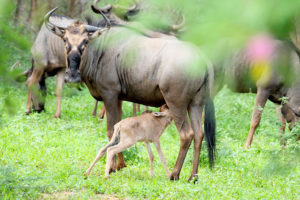
Little by little, our group became a community as we learned “The 13 Laws of LionHearted Leadership™” which Linda Tucker has gleaned from her many years of living with and protecting the Sacred White Lions. In her book, LionHearted Leadership™: The 13 Laws, she outlines laws which the lions seem to exemplify in their lives and community. They seem to me to be ideal directives for the formation of any community. They include (to paraphrase):
● Follow Your Paw-print: Walk your original path, your soul’s path.
● Celebrate Your Nature: Give thanks in all our actions, in gratitude for Nature’s gifts.
● Share the Roar: Open up lines of communication and interconnection with all things, restoring unity and harmony.
● Encourage Fresh Growth: Nurture others as nature constantly nurtures and restores.
● Protect the LionHeart: Radiate back into the world some of the light you receive from Source, the heart of the solar system.
● Serve Mother Earth: Reconnect with Mother Nature, restoring ourselves without harming her.
● Find Your Pride: Create unity and harmony with others by recognizing that our own self-worth is interconnected with theirs, not at their expense.
● Gain Full Responsibility: Take responsibility for your choices, become answerable for your own life.
● Live Your Dream: Act on positive intentions, recognizing that everything you create can be a co-creation with the great Creator of all that is Love, Light, and Truth.
● Steward Your Resources: Turn asset management into a sacred principle of good governance.
● Uncage Your Gift: Give joyful expression of talents, innate skills, and natural gifts, celebrating life for the greater good.
● Rediscover the Stars: Aspire to the highest and best versions of ourselves in all we do.
● Cleanse Your Kingdom: Proactively clean up corruption to restore health to our system and ecosystem—a necessary part of everyday health and hygiene.
These laws seem to be directives from the lions themselves, as they naturally live them out within their pride dynamics. And our group practiced them as we also interacted with the lions and the other “communities” within our little South African ecosystem. We learned to co-create together as we individually and collectively grew in our own sense of self and as a nurturing whole, cooking and cleaning together and supporting one another in our mutual growth and understanding.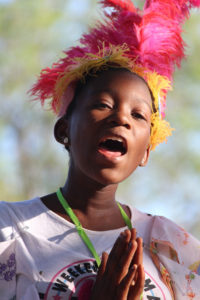
At the end of our time together, we each made a commitment of what we wanted to take into our everyday lives at home. One person chose to be more vigilant around her use of resources, buying only from secondhand shops whenever possible. Another committed to never accepting plastic straws in their drinks. Another decided to become much more committed to a vegetarian diet. One was going to set up a worm composting system for the Trust. And my friend Dick committed to picking up trash from the beach whenever we went out for a walk. While many of these are small steps, each one brings the world a little closer to becoming sustainable—which was the indigenous way to live in South Africa for millennia before the era of colonization.
To learn more about the Global White Lion Protection Trust, Linda Tucker’s books or videos, to join a program there, or to donate, please go to whitelions.org.
Dianne Brause grew up in a tight-knit farming community in Ohio, from which she began to explore the greater world at a young age. Her community experience includes living in a variety of shared housing situations, writing part of her M.A. thesis about a future intentional community she envisioned, and eventually cofounding Lost Valley Educational Center in Oregon in 1989. She lived there for 19 years before moving back to Ohio to care for her parents through their dying processes. Since then, she has primarily traveled the world, spending a great deal of time in the Middle East—where her visions for a peaceful world continue to be challenged. Dianne has finished all her courses for a Ph.D. and is waiting for the inspiration to tackle writing her dissertation, perhaps in the form of her own unique life story.
